Fact Sheet FS358
Tomato diseases can cause serious losses in high tunnels or greenhouses in New Jersey. Although high tunnels and greenhouses provide protection against adverse weather, conditions in these partially- or fully-enclosed structures can still provide a favorable environment for the development of important diseases. Tomatoes grown in either greenhouses or high tunnels are susceptible to the same diseases that attack tomatoes in the field.
Some of the most common fungal and bacterial diseases of tomatoes grown in high tunnels and greenhouses include Early blight, Late blight, Botrytis, White mold, and Bacterial canker, spot and speck. These common diseases produce distinct symptoms, making the diagnosis relatively easy.
Early Blight
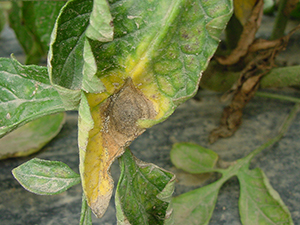
Early blight lesion on an infected tomato leaf with distinct concentric blackish-brown rings.
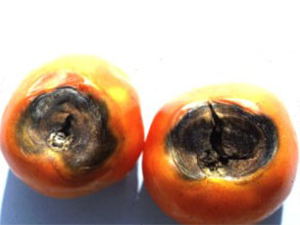
Early blight causing rot at the stem end of infected tomato fruit.
Early blight can infect tomato foliage and fruit. On tomato foliage, Early blight first appears as circular irregular black or brown spots on the older leaves of the plant. As these lesions enlarge, a series of dark concentric rings develop in the center of the spot creating a distinct target pattern. Over time, the tissue surrounding the Early blight lesions can yellow and cause the leaves to drop. Severe infestations of this disease can cause 100% defoliation of the plant. Early blight can infect the fruit through the calyx or stem attachment in the immature green or red fruit stage and can produce distinct target-like lesions similar to foliar infection. Defoliation caused by Early blight can reduce fruit yield and can leave the fruit open to sunscald injury. Control of Early blight begins with taking preventative measures. Keep foliage dry and use plant and row spacings, which allow for good air circulation.
Late Blight
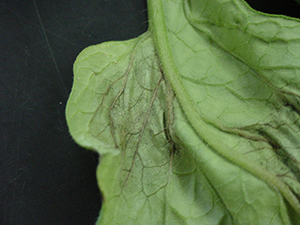
Sporulating Late blight lesion on the underside of a tomato leaf.
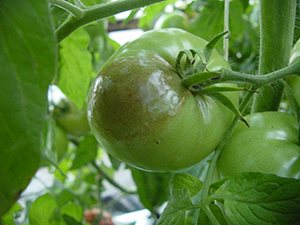
Late blight on mature green tomato fruit grown in the greenhouse.
Late blight is the disease historically associated with potatoes and the Irish potato famine of the mid-1800s. The Late blight fungus can also cause significant losses in tomato plantings. The disease will first appear as greasy-grayish indefinite patches on older leaves and stems. These spots enlarge during moist weather and may produce white fuzzy growth on the underside of infected leaves. The fungus may also attack immature, green tomato fruit causing dark greasy colored spots with a rough surface. These lesions may enlarge, turning the whole fruit brownish-black. Infected fruit often remain firm. Severe infestations can cause the foliage to brown and shrivel. To help reduce chances for Late blight, keep foliage as dry as possible. Keep relative humidity in structure below 90%. High relative humidity and wet foliage will favor Late blight development. Remove and bury any infected plant material from structure.
Powdery Mildew
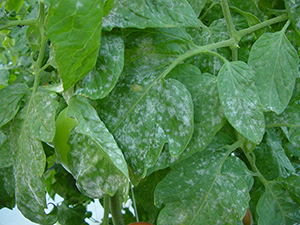
Powdery mildew on tomato leaves.
Powdery mildew is one of the most common foliar pathogens of tomatoes grown in high tunnels and greenhouses. Symptoms of Powdery mildew include the production of pure white ‘fluffy’ lesions on all vegetative parts of the tomato plant. Powdery mildew can cause 100% premature defoliation and greatly reduced yields and predispose fruit to sunscald injury if defoliation occurs during fruit set. Control of Powdery mildew begins with preventing conditions favorable for disease development. Structures need to be well-ventilated for adequate air movement and to help reduce relative humidity. Increasing plant spacing between plants and rows and keeping relative humidity low (RH<50%) may help reduce disease development. Regular scouting for early disease development and preventative fungicide applications will also help control Powdery mildew.
Botrytis Foliar Blight and Fruit Rot

Botrytis fruit rot on developing tomato fruit.
Botrytis can cause numerous losses in high tunnels and greenhouses when outside conditions are cool and cloudy and inside conditions become extremely humid. Botrytis can infect all vegetative parts of the tomato plant as well as developing fruit. On foliage and stems, Botrytis will cause light tan lesions that expand under favorable conditions. Lesions often have dark brown concentric rings where abundant conidia (spores) develop. Spores are blown onto healthy tissue or fruit and the disease can spread rapidly if left untreated. Control of Botrytis begins with preventative measures. Do not allow foliage to remain wet for long periods of time. Adequately ventilate the growing stucture to reduce the humidity and promptly remove all unharvested or aborted fruit from the growing area.
Timber Rot (White Mold, Sclerotinia)
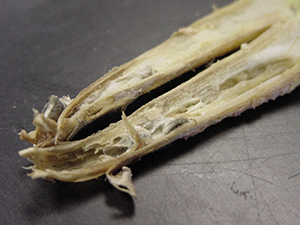
Stem infection caused by White mold. In many instances white fungal mycelium and black sclerotia will be present in infected tissue.
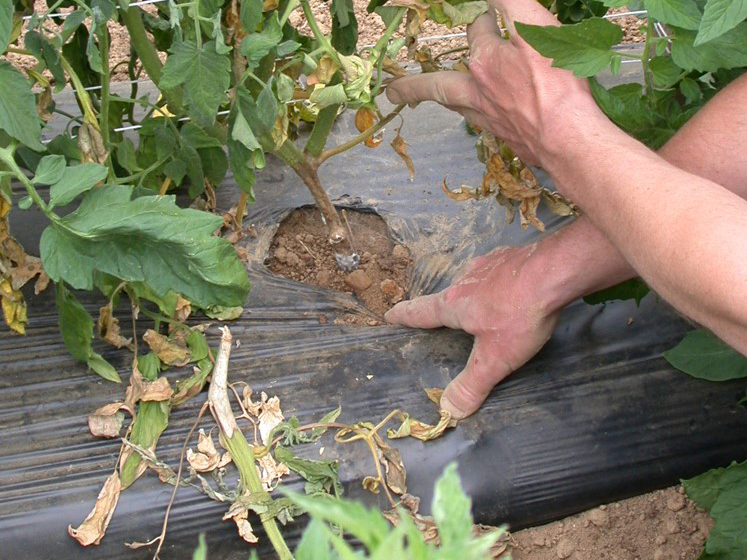
Stem of tomato plant infected with White mold.
Timber rot or White mold (Sclerotinia) can cause serious losses in high tunnel and greenhouse tomato crops that are grown in either natural soil or in bags or pots containing soilless mixes. In tomatoes grown in natural soil, the fungus can overwinter in the soil as sclerotia that act to initiate primary infections during the production season. For bagged and container crops, inoculum originates from an outside source from which spores are blown into the growing area. Symptoms of white mold include light tan lesions that typically develop on stems at or near the soil line or sometimes higher up on branches. Lesions girdle stems of infected plants, cutting off the flow of water and nutrients through the stems. Infected plants completely wilt over time, ultimately killing the entire plant. As lesions develop, stems become brittle and dry. Black sclerotia often develops on the surface of lesions or on the inside of infected stems.
Control of White mold begins with sanitary and cultural practices that reduce inoculum in the soil. In growing structures where tomatoes are planted into soil, proper crop rotation is extremely important, especially if White mold has been a problem in the past. Avoid continuous plantings of tomato crops. Soil can be fumigated to help reduce inoculum pressure. Soilless mixes should not be re-used or should be sterilized prior to reuse. Plants with suspected symptoms should be immediately removed from the growing area.
Bacterial Canker
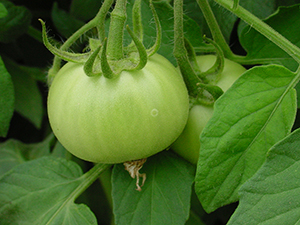
Symptoms of Bacterial canker with ‘bird’s eye’ lesions developing on green fruit.
Bacterial canker can cause grave losses in greenhouses or high tunnels. Symptoms often begin as marginal necrosis of tomato leaflets. Heavy infections can result in fruit infections that render the fruit unmarketable. Symptoms of fruit infection often begin on green fruit with the production of ‘bird’s eye’ lesions. Control of Bacterial canker begins with the use of certified or ‘clean’ transplants and seed. Seed should be treated to reduce chances for seed-borne development of the disease. Bacterial canker can be spread from plant to plant by workers’ hands during pruning, tying, and harvesting. Keep tomato foliage dry by using drip irrigation. Avoid working on the crop when the foliage is wet and/or when the humidity is high.
Bacterial Spot and Speck
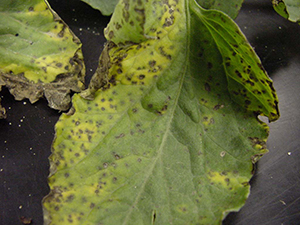
Typical symptoms of bacterial leaf infections on infected tomato foliage.
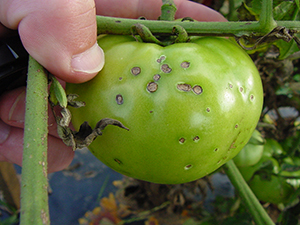
Symptoms of Bacterial spot on infected tomato fruit.
Bacterial spot and speck can also cause considerable losses in greenhouse and high tunnels. Like Bacterial canker, both Spot and Speck can be seed-borne. Transplants should be certified ‘clean’ and seed should be heat-treated. Symptoms of Spot and Speck include small, circular, black, water-soaked lesions on the foliage. Chlorotic spots or yellow ‘halos’ often form around lesions.
Like Bacterial canker, avoid working on the crop when the foliage is wet due to watering or high humidity conditions. During heavy infection, Bacterial spot and speck can infect fruit rendering it unmarketable. Symptoms include dry, scabby circular lesions that are often slightly sunken or raised.
Controlling Important Diseases of Tomatoes Grown in Greenhouses and High Tunnels
Controlling diseases in greenhouses and high tunnels always begins with preventative measures. Proper cultural practices that help to reduce potential sources of inoculum and management practices that help to avoid wet, humid conditions from developing in the growing structure can significantly reduce the chances for disease development. All transplants and/or seed should be certified disease-free prior to use. Soil fumigation can be helpful in reducing the amount of potential inoculum. Ventilation windows and roll-up side vents should be closed or lowered during rainfall events to help keep the foliage as dry as possible. Growing structures should be vented periodically to appropriate humidity levels.
Photo credit: Sally Miller, OSU (Figure 2)
May 2020
Copyright © 2025 Rutgers, The State University of New Jersey. All rights reserved.
For more information: njaes.rutgers.edu.
Cooperating Agencies: Rutgers, The State University of New Jersey, U.S. Department of Agriculture, and Boards of County Commissioners. Rutgers Cooperative Extension, a unit of the Rutgers New Jersey Agricultural Experiment Station, is an equal opportunity program provider and employer.

